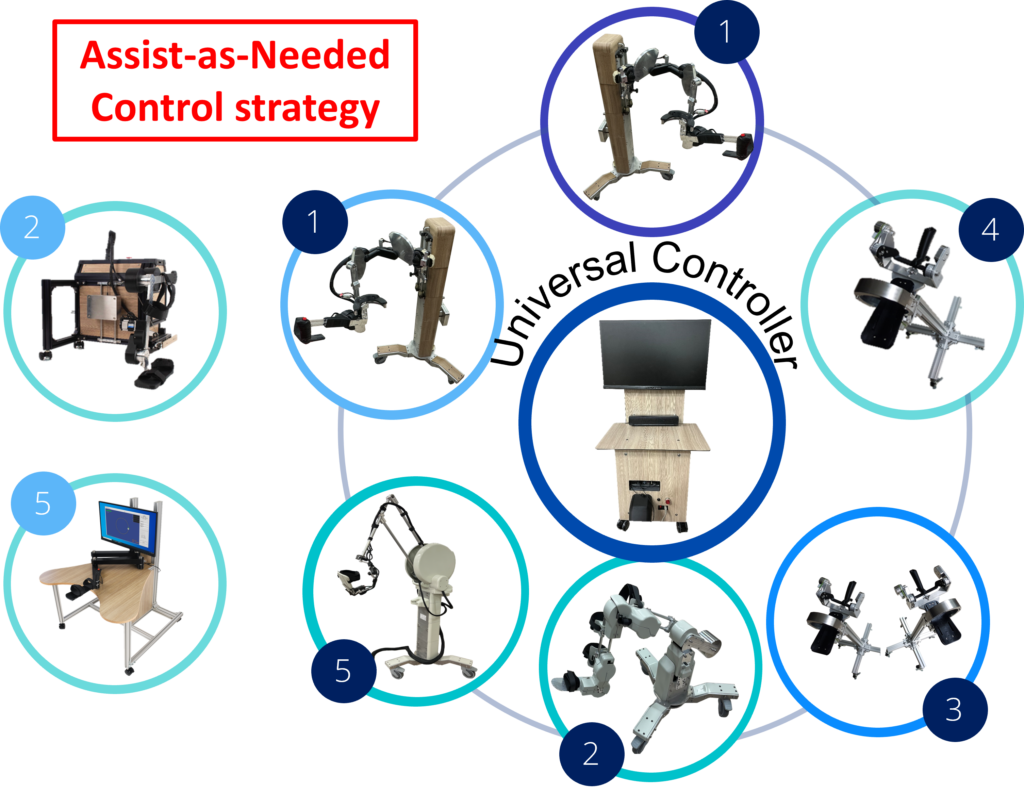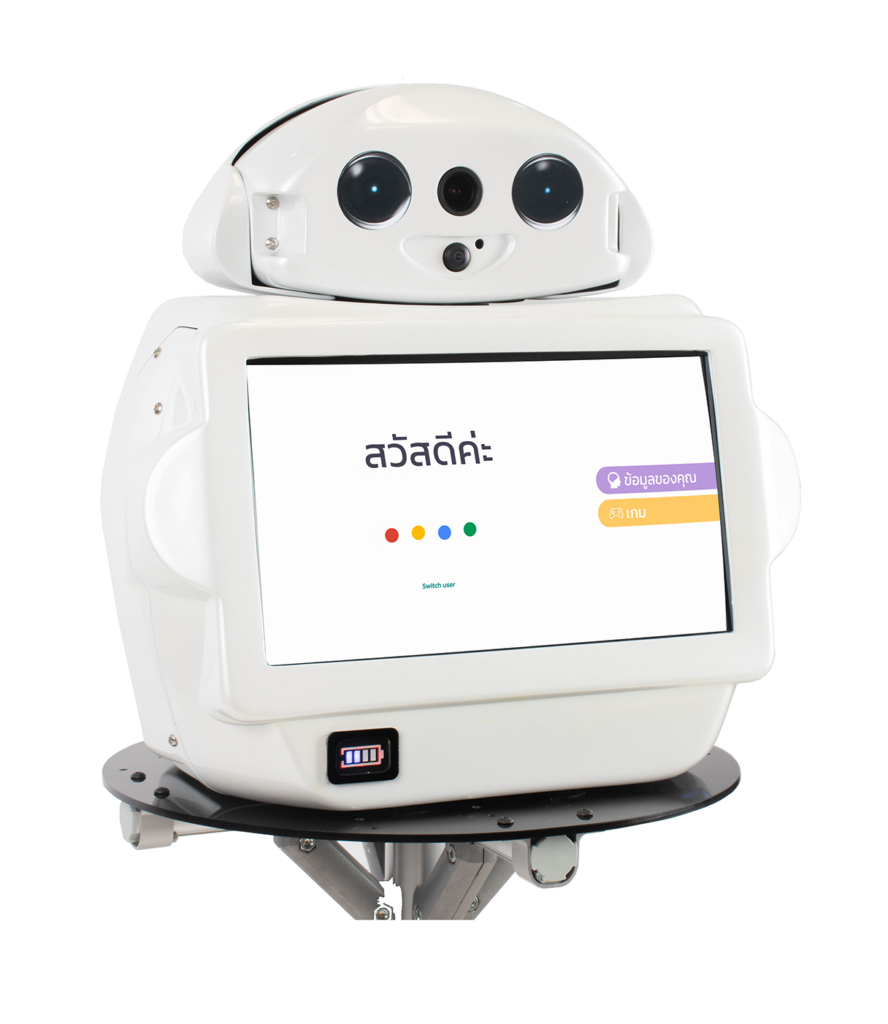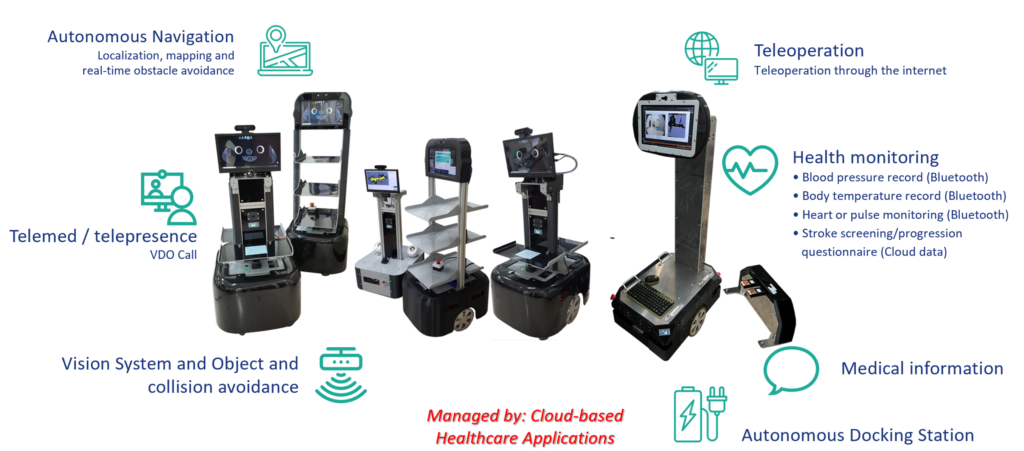One of the leader in robotics technology and manufacturing research center in Thailand
Stroke is a significant global public health issue. The World Stroke Organization (WSO) reports that stroke is a major cause of death worldwide, with approximately 80 million people affected by stroke and 50 million people disabled as a result of it. In Thailand, this accounts for 62.5% of the population, according to the Ministry of Public Health’s health statistics report. The incidence rate is estimated to be around 690 cases per 100,000 population, and after having a stroke, only 5-20% of patients experience a full recovery of upper limb function, while 30-70% of patients experience severe weakness and require rehabilitation for longer than six months. This leads to a loss of daily living abilities and work productivity, impacting life in society and overall quality of life.
The recovery of motor function on the weak side to aid in the improvement of brain and motor control recovery can be achieved in several ways. The use of robotics for rehabilitation is increasingly popular today, as robots can assist in the recovery process from the early stages with minimal residual motor function to chronic stages. This enables patients to repetitively practice arm movements more frequently compared to traditional methods, resulting in skill acquisition proportional to the number of repetitions. Incorporating gaming systems and feedback mechanisms makes rehabilitation engaging, enjoyable, and challenging. These features contribute to the effectiveness of rehabilitation.
As patients regain more motor function, robots equipped with signal detection systems enable them to perceive force feedback, position, and movement speed. This leads to the development of patient-specific progression supervising systems, which record and track the individual progress of users. These systems also adapt movement patterns and muscle strength changes generated by the robot.
A systematic review has shown that using robotic devices for limb motion training in rehabilitation significantly enhances the recovery of motor function and the ability to perform daily activities.
The development of physical therapy robots for stroke patients with hemiparesis is a project that has diversified the development of robots for rehabilitation to suit the recovery needs of stroke patients with varying degrees of hemiparesis. The developed robotic systems can be categorized into two main types: 1) Exoskeletons, where the robot mechanism is worn on the patient’s arm, forearm, or leg, and 2) End-effectors, where the patient’s hand directly interacts with the robot’s end-effector attached to the arm. Depending on the rehabilitation objectives for different body parts (i.e., upper limb, lower limb, and forearm) and the specific needs of patients, various types of robots have been developed, including:
Furthermore, devices to support telemedicine or tele-rehabilitation have been developed, including:

The aforementioned medical robots have been installed and used in real healthcare settings. They have undergone continuous development and improvement for over four years. The current robots are considered the third generation, and we have now developed a universal controller system that can be used with various types of robots that have been developed. This allows healthcare facilities to plan and acquire a wide variety of robots while reducing budgetary constraints. Additionally, the maintenance and upkeep of these robots have become more efficient and cost-effective. When integrated with computer network systems, it enables remote programming updates and improvements.
This developed robot is a technology that we have entirely developed ourselves. It has been engineered to be compact in size, easy to relocate, user-friendly, suitable for various types of training, and most importantly, it has been designed with mechanical engineering principles to control the robot’s operations seamlessly between position control, speed control, and assistive force provided by the robot to the patient during training. This mechanical control system is highly secure and operates with an Assist as Needed or Active Assistive Control Strategy, where the robot exerts assisting force only when the patient requires it. Additionally, we have obtained patents related to the design of the robot’s structure and auxiliary robotic devices, enabling the use of small-sized, low-power-consuming, and easily relocatable Brushless motors, facilitating home-based rehabilitation in addition to hospital use.
The use of robots for rehabilitation comes in various forms, including specific motion-based recovery activities that can be directly programmed from the outset of rehabilitation and can be stored for the entire session. Training is divided into courses, and each course consists of sessions. For example, one course may last 20 days or 20 sessions. There is a real-time data recording system in each training session that records both variables and parameters related to the training. This includes the percentage of assistance provided by the robot in real-time when the individual performs the task independently, the magnitude of assistive forces provided by the robot throughout the training, and the movement speed, all of which are recorded and stored. This data can be transmitted and stored in a cloud computing system, allowing us to develop additional components or extensions to analyze the data related to the training of various robotic systems stored in the cloud. This enables us to further enhance and advance effective rehabilitation approaches under the guidance of medical ethics.
In addition, there is also training through gaming as a part of physical rehabilitation, which is a widely adopted approach today. Computer gaming systems come in two forms: 1) games we have developed ourselves, which assist in functional recovery, such as games that involve catching and avoiding falling objects, games involving hitting or kicking a ball against a wall, and games with random commands at 8 different points, form in circular shape, among others. Furthermore, we have developed an interface that integrate the robot arm with arcade games or games available in the market to make them suitable for rehabilitation.
The computer gaming system integrated into rehabilitation not only provides stimulating and motivating games but also offers services in a stress-free environment. This approach helps reduce the boredom associated with rehabilitation. Therefore, it is crucial to engage patients in activities that make them feel like they are constantly doing something new. Introducing games into the rehabilitation process can significantly boost motivation and make patients enjoy the rehabilitation experience, creating a desire to use the equipment continuously and thereby making the rehabilitation more effective.
This medical robotics system has taken into account medical equipment standards and has been tested through medical ethics committees, adhering to the IEC60601-1 and IECC60601-1-2 standards for medical robots. Moreover, we have established a medical robotics manufacturing facility in compliance with the ISO13485 standard for more than three years. Each model of medical robot is developed following guidelines for medical equipment development, procurement according to medical standards, manufacturing of various medical device components as per specified standards, manufacturing techniques as prescribed, quality control systems post-production, storage of completed robots, and safety systems for robot use, including problem-solving in case of product design flaws. All of these standards are essential for the development of each medical robot model, in accordance with ISO 13485 standards.
Furthermore, within the ISO13485 system, it is essential to include standards for post-installation care and service, as well as user satisfaction analysis. The developed robots have been installed and used for practical purposes in many medical facilities as well as home rehabilitation services around the country. In addition to patients with cerebrovascular diseases, we have also conducted clinical trial under medical ethics committees for other groups of patients, including the elderly and Parkinson’s disease patients. For example, we tested the Telerehabilitation robot for home-based Parkinson’s disease patient training and installed wearable sensors for posture and gait analysis. The use of Telerehabilitation robots installed at the homes of Parkinson’s disease patients for a clinical trial, involving more than 40 cases.
โครงการพัฒนาเทคโนโลยีหุ่นยนต์และอุปกรณ์ทางการแพทย์เพื่อการฟื้นฟูสมรรถนะผู้ป่วยโรคหลอดเลือดสมอง และ ผู้ป่วยที่มีอาการโรคทางระบบประสาท สำหรับแขน, ขา และ ข้อมือแบบครบวงจร
The Project for the Development of Robotics Technology and Medical Devices for the Rehabilitation of Stroke and Neuro-disorder Patients for Arms, Legs, and Hands in a Comprehensive Manner


โครงการนี้เป็นการพัฒนาเทคโนโลยีหุ่นยนต์เพื่อดูแลผู้สูงอายุ และ ช่วยในการขยายการบริการทางการแพทย์ในรูปแบบของ Telemedicine และ Telepresence โดยที่หุ่นยนต์ในโครงการนี้จะมีลักษณะเป็นแพลตฟอร์มซึ่งมี 2 ประเภทคือ หุ่นยนต์แบบตั้งโต๊ะ (Desktop-type Robots) และ หุ่นยนต์เคลื่อนที่ได้แบบอัตโนมัติ (Autonomous Mobile-type Robots)

ข่าวสารและความเคลื่อนไหวของพวกเรา
This center was established in 1993 by Prof.Viboon Sangveraphunsiri.
© 2022 Created with Royal Elementor Addons
Tel: +66(0) 2 – 218 – 6449
Line: @haxter.robotics
ตึกโคลัมโบ ชั้น 1 – 2 คณะวิศวกรรมศาสตร์ จุฬาลงกรณ์มหาวิทยาลัย
254 ถนนพญาไท แขวงวังใหม่
เขตปทุมวัน กรุงเทพมหานคร 10330
2nd floor Columbo building, Faculty of Engineering, Chulalongkorn University
254, Paya Thai road, Wang Mai, Pathum Wan, Bangkok, 10330